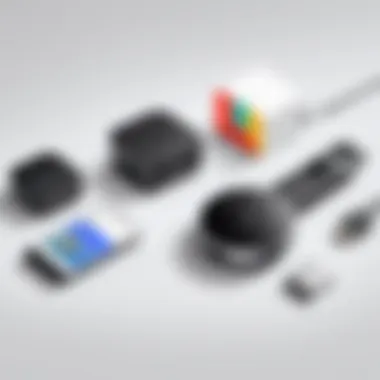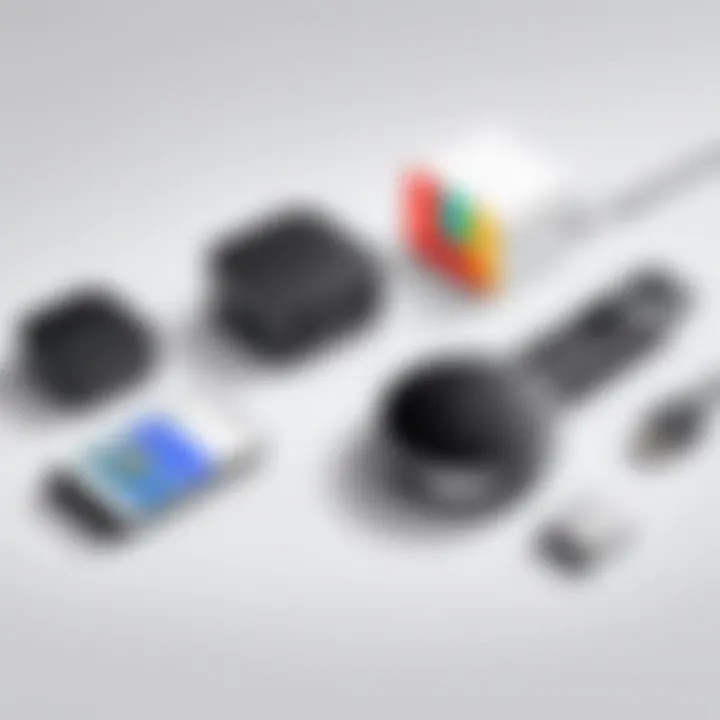Exploring the Google Cast App: Key Features Explained


Intro
The emergence of digital media streaming has transformed how we consume and interact with content. Among various tools available, the Google Cast app stands out for its ability to bridge the gap between devices and enhance user experience across multiple platforms. This section will explore what the Google Cast app is, focusing on its core functionalities and significance in today's technology landscape.
The Google Cast app enables users to stream music, videos, and photos from their devices directly to compatible smart TVs and speakers. Its role in the digital ecosystem cannot be underestimated, especially for IT professionals and tech enthusiasts who seek efficient media management solutions.
With an array of integrated features, this app offers seamless connectivity with a variety of devices. By understanding its capabilities, professionals can leverage the Google Cast app to optimize media consumption, enhance interoperability, and refine user experience.
Product Overview
Key Features
The Google Cast app is characterized by several pivotal features that enhance its usability and functionality:
- Device Compatibility: The app supports both Android and iOS devices, along with various smart TVs, sound systems, and streaming devices. This extensive compatibility ensures that users can cast content effortlessly.
- Multi-Room Streaming: Users can stream content to multiple devices simultaneously, facilitating a synchronized media experience in different locations within a space.
- Easy Interface: The app provides a user-friendly interface, allowing for straightforward navigation. Even non-tech-savvy individuals can operate the app efficiently.
- Voice Control Integration: Compatibility with Google Assistant enables voice commands, making it easy to control playback without physical interaction.
- Quality Streaming: Utilizing high-quality transmission protocols allows for reduced lag and improved streaming performance.
Technical Specifications
To understand the underlying capabilities of the Google Cast app, it is crucial to consider its technical specifications:
- Supported Formats: The app supports a variety of audio and video formats including MP4, MP3, MKV, and more.
- Connectivity: Google Cast functions over Wi-Fi, leveraging local network connections for smooth streaming.
- Resolution Support: The app supports streaming in high definition, including 1080p and 4K resolutions, depending on the capabilities of the receiving device.
- Security: The app incorporates encryption protocols to ensure secure network communication during streaming sessions.
"The Google Cast app exemplifies how technology can enhance content accessibility and flexibility."
Understanding these features and specifications provides a solid foundation for exploring the performance and practical use of the Google Cast app. This knowledge is vital for IT professionals aiming to optimize their technological solutions.
Prolusion to the Google Cast App
The Google Cast app plays a vital role in media streaming by providing a seamless interface for content sharing across devices. In today's digital landscape, where diverse media consumption is prevalent, understanding this app’s functionality is crucial. It enables users to stream audio, video, and images from their mobile devices to television or speakers with ease.
Defining the Google Cast App
The Google Cast app is designed to facilitate the casting of multimedia content from a sender device, like a smartphone or tablet, to a receiver, such as TVs or smart speakers. This technology allows for easy content management without the need for cumbersome cables or complex setups. Users can choose from various compatible applications, broadening their access to entertainment and interactive content.
Casting utilizes a simple and intuitive approach. By connecting both the sender and receiver devices to the same network, users can send their preferred content with just a few taps.
Evolution of Streaming Technology
The advancement of streaming technology has been marked by significant transitions, evolving from basic file sharing to robust digital media ecosystems. Initially, media playback relied on physical media like DVDs and CDs. Then, as internet speeds improved, streaming services began to emerge, changing the user experience dramatically.
With this evolution, the introduction of the Google Cast app represents a landmark in how content is consumed. The app integrates with numerous streaming platforms, allowing a smooth transition from traditional viewing methods to more dynamic, interactive experiences. It also reflects a broader trend towards mobile-first media consumption where users expect to access entertainment anywhere, anytime. This shift towards versatility in media interactions is not just a convenience but an expectation that the Google Cast app fulfills.
Core Principles of Google Cast
Understanding the core principles of the Google Cast technology is essential for anyone looking to utilize its features effectively. These principles form the foundation upon which the entire system operates, influencing both user experience and functionality. By grasping how these principles interact, one can unlock the full potential of the Google Cast app in various environments, especially in media streaming. This knowledge aids IT professionals in making informed decisions about their media management strategies.
Working Mechanism
The working mechanism of Google Cast is based on a client-server architecture. In simple terms, there are two main components at work: the sender and the receiver. When initiating a cast session, a sender device, such as a smartphone, communicates with the Google Cast-enabled receiver, typically a smart TV or a streaming device. This communication involves using a local network, often Wi-Fi, to transmit commands and arrange the streaming of content.
A significant aspect of this mechanism is that the sender device does not directly stream the content. Instead, it sends a request to the receiver to retrieve the specified content from the internet, allowing for a smoother playback experience. This design minimizes the burden on sender devices, making it easier to use less resource-intensive applications while ensuring high-quality video or audio playback.
Components of the System
The Google Cast system comprises several key components, each playing a vital role in its overall function.
Sender Devices
Sender devices are crucial in the Google Cast system. These devices are where the casting action begins. Common examples include smartphones, tablets, and computers. A key characteristic of sender devices is their versatility. They can handle various media types and can access multiple apps and services.
One significant advantage of sender devices is their ability to act as remote controls for the casted content. Users can pause, rewind, or switch content remotely. However, while sender devices are powerful, they do rely on a stable connection to send commands effectively, which can be a limitation in some cases.


Receiver Devices
Receiver devices are the endpoints in the Google Cast ecosystem. They are responsible for receiving commands from sender devices and retrieving content from the internet. Smart TVs, Chromecast devices, and compatible sound systems serve as examples of receiver devices.
A remarkable feature of receiver devices is their ability to support high-definition video formats and surround sound audio. This aspect makes them a preferred choice for high-quality media consumption. The downside may include the potential need for specific updates or configurations to ensure compatibility with various sender devices, although most receivers are designed to work seamlessly within the Google Cast environment.
Cast SDK
The Cast Software Development Kit (SDK) is an integral part of the Google Cast framework, designed for developers wishing to create compatible applications. The Cast SDK simplifies the integration of casting functionality into apps, enabling a seamless transition between sender and receiver devices in their applications.
One of the key advantages of the Cast SDK is its comprehensive support documentation, which assists developers in understanding how to implement casting features effectively. Furthermore, the SDK offers various APIs to enhance user experience, such as allowing for custom controls and notifications during playback. However, developers may need to invest time in learning the SDK's features and best practices to maximize its potential, which can be a consideration for those new to the platform.
"The Google Cast system harmonizes the interaction between sender and receiver in ways that elevate streaming experiences, emphasizing the importance of each component in achieving a successful media solution."
In summation, understanding the core principles of Google Cast—including its working mechanism and the key components involved, such as sender devices, receiver devices, and the Cast SDK—provides essential insights for professionals looking to implement this technology. The interplay of these elements influences how effectively content is managed and streamed, making this knowledge invaluable.
Features of Google Cast App
The features of the Google Cast app are essential for comprehending its role in digital media streaming. Designed to facilitate seamless interaction between various devices, these features enhance the user's experience. They broadens the scope of content consumption while maximizing connectivity across devices. By understanding these functionalities, IT professionals can better leverage the platform's capabilities in diverse applications.
Device Compatibility
Device compatibility is a core feature that determines the versatility of the Google Cast app. This functionality allows users to cast media from smartphones, tablets, and laptops to a wide range of receiver devices. Google Cast supports both iOS and Android systems, ensuring compatibility with a varied user base.
Moreover, devices such as Chromecast, Google Nest Hub, and smart TVs are all part of the ecosystem. This compatibility makes it easier for users to integrate the app into their existing technology setups without additional challenges. Broad support for numerous devices ultimately enhances the accessibility of streaming media in both personal and professional scenarios.
User Interface and Experience
The user interface of the Google Cast app has been designed with simplicity in mind. A clean layout allows users to navigate effortlessly between their content options. The app's design gives priority to user experience, focusing on minimizing distractions and ensuring accessibility of features.
Users appreciate the straightforward controls, which enable casting with just a few taps. This efficient design makes it suitable for users with varying degrees of technological proficiency. Furthermore, the functionality is intuitive enough to allow quick access to favorite applications and services, enhancing overall satisfaction in media management.
Content Options Available
The Google Cast app offers a diverse range of content options, catering to different user needs. This flexibility is a key advantage and can be broken down into three main areas:
Streaming Services
Streaming services represent a significant part of the Google Cast experience. The app supports numerous popular platforms, such as YouTube, Netflix, and Spotify. These services allow users to access vast libraries of multimedia content directly.
A standout characteristic of streaming services is their on-demand nature. Users can watch or listen to content anytime, distinguishing it from traditional media consumption methods. However, while these services provide a rich array of options, users may require subscriptions that can increase overall costs.
Local Media Playback
Local media playback is another beneficial feature provided by the app. This function enables users to cast media stored on their devices, such as photos, videos, and music files. The key characteristic here is that it allows retrieval of content without reliance on internet access, making it a robust choice in various scenarios.
Local playback is particularly advantageous in settings where users have large personal media libraries. However, there can be challenges if file formats are unsupported, which may limit compatibility of certain files.
Screen Mirroring
Screen mirroring allows users to duplicate their device screens onto larger displays. This feature is ideal for sharing presentations, images, or videos during meetings or gatherings. Its key characteristic lies in providing real-time display, which can make collaborative tasks more efficient.
While the convenience of screen mirroring is clear, there are some drawbacks. The quality of display can vary based on network strength, and responsiveness may lag if the connection is unstable, potentially impacting user experience during critical tasks.
In summary, the features of the Google Cast app enhance functionality and support a seamless digital content experience, contributing significantly to its popularity and application in various environments.
Setting Up the Google Cast App
Setting up the Google Cast App is a fundamental step for users looking to fully utilize its capabilities in media streaming. This process enhances the various functionalities and features available through the app. It's not just about ease of use; setting things up correctly fosters a seamless connection between devices, which is critical for optimal performance. Understanding how to set up the app allows users to overcome potential hurdles and significantly increases user satisfaction.
Installation Steps
To begin with the installation of the Google Cast app, users need to follow straightforward steps to ensure smooth integration.


- Download the App: The first step involves downloading the Google Cast app from the Google Play Store or Apple App Store. The app is accessible on most devices, including smartphones and tablets.
- Launch the App: After installation, users should open the app. It typically requests the necessary permissions which should be granted to enable full functionality.
- Select Your Device: Once the app is running, it can detect any compatible Google Cast devices nearby. Users need to select the desired device they wish to cast content to.
- Follow On-Screen Instructions: The app provides clear prompts that guide users through the process. This includes connecting to Wi-Fi networks and confirming settings.
This simple step-wise procedure lays the foundation for a robust casting experience.
Configuring Network Settings
Proper network settings are crucial for efficient streaming with Google Cast. It ensures that the devices communicate effectively without interruptions. Here are the key considerations:
- Wi-Fi Network Requirements: The Google Cast app requires all devices to be on the same Wi-Fi network. This allows for direct communication and smoother data transfer.
- Network Band Frequency: For better performance, it's advisable to use a 5 GHz network band if available. This band reduces interference and can improve streaming quality.
- Router Settings: Certain settings on the router, such as Quality of Service (QoS), can be adjusted to prioritize streaming traffic. This can help minimize latency and buffering when using the app.
Making the right adjustments can enhance the streaming experience and ensure continuity in connection.
Linking Compatible Devices
Linking devices is an essential part of setting up the Google Cast app. This connection allows for streamlined communication and media sharing. Steps for linking compatible devices include:
- Identifying Supported Devices: Begin by identifying devices compatible with Google Cast, such as smart TVs, speakers, and Chromecast devices. The app can help in detecting these automatically.
- Connect through the App: The Google Cast app provides a straightforward mechanism to link devices. Via the app, select the device you want to link, and follow the instructions provided.
- Verify Connection: After linking, ensure that the device is recognized by the app. This may involve testing by casting a short video to check the connection.
Linking devices correctly not only simplifies the process but also improves accessibility and future interoperability.
Ensuring each device is properly set up enhances the overall usability and effectiveness of the Google Cast application, which ultimately leads to a better media streaming experience.
Integration with Other Platforms
The integration of the Google Cast app with various platforms enhances its utility and expands its functionality significantly. In a world increasingly driven by connectivity, understanding how this app interacts with other devices and services is crucial. As digital environments evolve, seamless integration becomes a hallmark of effective tech solutions.
Compatibility with Smart Home Devices
Google Cast boasts impressive compatibility with a host of smart home devices. This integration allows users to control their home entertainment systems efficiently. For example, devices like Google Nest and Philips Hue Lights can be synchronized with the Cast app. By doing this, users have greater control over their media experience, making it more dynamic. The ability to adjust lighting or volume through simple voice commands using Google Assistant illustrates the power of this integration. Consider these benefits:
- Unified Control: Users can manage various aspects of their environment from one central application.
- Enhanced User Experience: Combining entertainment with ambiance creates a more immersive experience.
- Energy Efficiency: Smart integrations often lead to better energy management, allowing devices to run only when necessary.
This compatibility underscores the relevance of the Google Cast app within broader smart home ecosystems, making it an essential consideration for tech professionals assessing new solutions.
Collaboration with Mobile Apps
The collaboration between the Google Cast app and mobile applications represents a fundamental aspect of its architecture. The app acts as a bridge, enabling users to cast content from their mobile devices to larger displays effortlessly. This capability invites a plethora of mobile applications to engage more profoundly with users through casting features. Notable applications include platforms such as YouTube and Netflix, where users can cast videos directly from their smartphones. The integration offers a variety of advantages:
- Convenient Content Sharing: Users can share photos, videos, and presentations with friends or colleagues with ease.
- Versatile Accessibility: Many applications support casting, enhancing user engagement across multiple platforms.
- Streamlined User Interface: The casting mechanism is generally found within the existing mobile app interface, making it intuitive for users.
Central to the conversation is how well these integrations support modern digital lifestyles, reflecting the need for synchronized devices in an interconnected world.
Performance and Quality Metrics
In understanding the Google Cast app, evaluating its performance and quality metrics is crucial. These metrics determine how effectively the app delivers content and experiences for users. High-quality performance influences user experience, which directly affects engagement levels and satisfaction. Focusing on performance ensures that users can seamlessly stream content without interruptions. It addresses their expectations and preferences in a rapidly evolving digital media landscape. Here, we will dive into specific elements such as streaming quality and issues like latency and buffering.
Streaming Quality Definition
Streaming quality refers to the overall visual and audio clarity of the content being cast through the Google Cast app. This quality can be influenced by several factors including the resolution of the content, the capability of the streaming device, and the stability of the network connection. In general, higher resolution formats such as 4K and HDR provide better visual experiences but also require robust internet speeds.
Key aspects often associated with streaming quality include:
- Resolution: Higher resolution provides clearer and more detailed images.
- Bitrate: This measures the amount of data transmitted per unit of time. A higher bitrate often indicates better quality.
- Audio Quality: High-definition audio formats can enhance the overall experience.
Understanding streaming quality is essential for professionals aiming to provide seamless multimedia experiences. Users expect minimal quality degradation, and they value consistency in performance.
Latency and Buffering Issues
Latency refers to the delay between a user's action, such as pressing play, and when the content actually starts playing. Buffering is the temporary storage of data while it eases the flow of streaming. High latency and excessive buffering can severely hamper user satisfaction and can lead to frustration.
Professionals in the field need to address these issues proactively:
- Minimize Latency: Achieving low latency is vital for real-time interactions. This can often involve optimizing network conditions and ensuring devices used are within close proximity.
- Reduce Buffering: Strategies to reduce buffering include improving bandwidth, optimizing content delivery networks, and selecting appropriate codecs.


Effective management of latency and buffering ensures a smooth streaming experience. Both factors directly impact user interaction. Addressing performance metrics helps maintain a balance between quality and user experience, which is increasingly important in professional settings where presentations and collaborative projects rely on digital streaming.
Use Cases in Professional Environments
The adoption of the Google Cast app in professional environments reflects a growing need for flexible and dynamic media presentation solutions. The application offers significant advantages in enhancing productivity and collaboration across various professional settings. It allows multiple users to stream content directly from their devices, making presentations and meetings more engaging and interactive.
Presentations and Meetings
In today’s fast-paced business world, effective presentations are crucial. Google Cast streamlines the process of sharing information. Users can cast slideshows, videos, and other materials from devices such as laptops or tablets. This capability eliminates the need for cumbersome cables and adapters, allowing for a tidy setup and a smoother transition between topics during meetings. Presenters can control their content directly from their devices, which increases their ability to engage with the audience rather than focusing on equipment management.
Furthermore, using Google Cast in meetings encourages real-time collaboration. Participants can contribute or modify presentations from their own devices, leading to a more dynamic discussion.
"The ability to present from anywhere in the room fosters a more interactive environment, which is beneficial for team discussions and brainstorming sessions."
Collaborative Projects
Collaborative projects stand to gain immensely from employing the Google Cast app. This tool enables teams to work together effortlessly in shared digital spaces. It allows multiple users to display content simultaneously on a large screen, facilitating effective discussion and decision-making processes.
The app’s integration with various productivity tools supports project management initiatives. Individuals can cast project updates, graphs, or digital boards directly to a central screen, keeping everyone aligned with the project’s status.
Using Google Cast also reduces the barriers often present in hybrid working environments. Teams can operate seamlessly whether they are in the same location or working remotely. Using Google Meet alongside the casting feature allows remote team members to share their screens with onsite participants, fostering inclusivity.
Challenges and Considerations
Understanding the challenges and considerations of using the Google Cast app is crucial for any IT professional or tech enthusiast. As media streaming becomes ubiquitous, the implications on user privacy and security cannot be overlooked. Navigating these challenges ensures better user experience and maintains trust in digital systems. By acknowledging and addressing privacy and security issues upfront, users can make informed decisions when integrating streaming solutions into their workflows.
Privacy Concerns
Privacy is a paramount concern in the digital age, especially with devices that connect to networks and other systems. The Google Cast app relies on the transmission of data between sender devices and receiver devices, which can expose user information to potential breaches. Users must be aware that activities such as streaming video and audio, or even mirroring screens, can reveal personal data, including browsing habits and location.
Some critical privacy considerations include:
- Data Collection: Google Cast may collect user data to enhance the service. Users need to review data collection policies and opt for privacy settings that limit unnecessary sharing.
- Network Security: Using public Wi-Fi networks increases the risk of data interception. It's advisable to stream content only over secure, private networks.
- User Behavior: Be mindful of the information accessed while using the Cast app. Activities performed on apps or devices can become visible to those sharing the network.
To mitigate these privacy issues, users should:
- Regularly update the Google Cast app to ensure they receive the latest security and privacy features.
- Adjust privacy settings within the app and on their devices.
- Educate themselves on how their data is used to make informed decisions about their digital footprint.
"Awareness of privacy risks is essential for those utilizing the Google Cast App in professional settings."
Security Risks
Security is intertwined with privacy but focuses more on protecting the integrity of data and devices connected within the Google Cast ecosystem. The potential vulnerabilities in this framework warrant careful consideration from users.
Specific security risks involve:
- Unauthorized Access: If a device connected to the Google Cast app lacks sufficient protection, outsiders may gain access to one’s network and associated files.
- Malware Attacks: Streaming devices can be targeted by malware that can compromise user data and device functionality. Thus, using reputable, updated streaming devices is crucial.
- Phishing Scams: Users might encounter phishing attempts that exploit the Cast ecosystem. Recognizing suspicious activity is necessary to safeguard sensitive information.
To enhance security while using the Google Cast app, users should:
- Implement strong, unique passwords for their accounts and devices.
- Enable two-factor authentication where possible to add an additional layer of security.
- Regularly check for software updates that address known vulnerabilities.
By emphasizing both privacy and security, users can maximize the benefits of the Google Cast app while minimizing potential risks.
Future of the Google Cast App
The future of the Google Cast app is important as it signifies the ongoing evolution of digital streaming technology. As user habits change and the demand for seamless content delivery grows, the app must adapt to remain relevant. Key elements such as increasing compatibility with devices and enhancing user experience will be vital for its sustained success. The app needs to address concerns surrounding security and privacy while improving its performance metrics. That way, it can maintain user trust and engagement.
Technological Advancements
Technological advancements play a critical role in shaping the future of the Google Cast app. Emerging technologies such as 5G and Artificial Intelligence are changing how media is consumed and interacted with. The implementation of 5G networks allows for faster streaming and improved connectivity, which is essential for apps like Google Cast that heavily rely on stable and quick data transfer.
In addition, AI can enhance user personalization. For instance, AI algorithms can analyze user behavior to recommend relevant content based on past interactions. This not only improves user experience but also increases engagement rates among users. Moreover, technological advancements in machine learning could provide faster troubleshooting solutions for users facing issues with the app.
Potential Market Trends
Potential market trends will also influence the direction of the Google Cast app. As smart home technologies continue to proliferate, the integration of Google Cast with various devices such as smart TVs, speakers, and even kitchen appliances may become more common. The demand for multi-device connectivity is increasing, and users expect a seamless experience across different systems.
Another trend is the rise of subscription-based content models. Streaming platforms like Netflix and Hulu have changed how consumers access media, favoring services that offer greater flexibility and variety. The Google Cast app will need to keep up with these trends by ensuring compatibility with an ever-increasing number of platforms and services.



